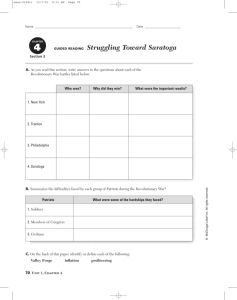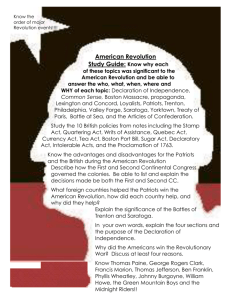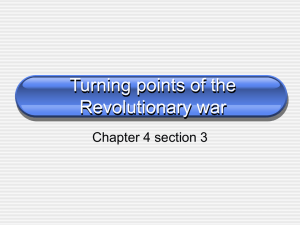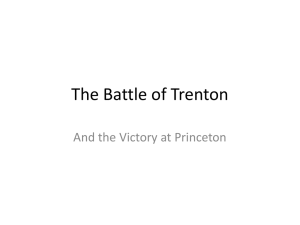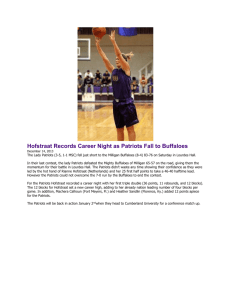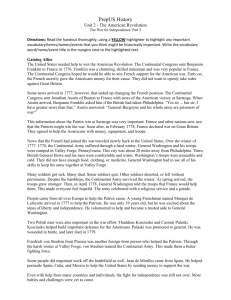Chapter 4 Section 4 - Putnam County Schools
advertisement
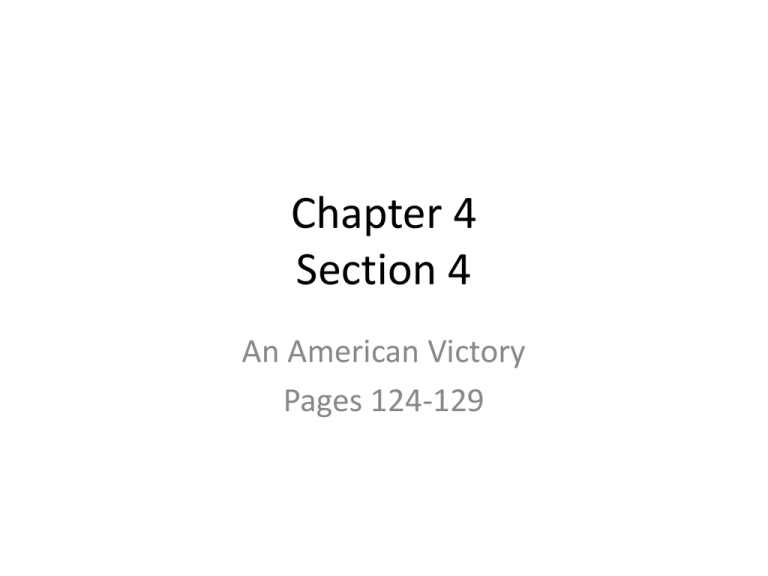
Chapter 4 Section 4 An American Victory Pages 124-129 Objectives • 1. Explain the importance of the Battles of Trenton and Saratoga. • 2. Describe how the Patriots defeated the British in the West and the South. • 3. Summarize the terms of the Treaty of Paris. The War Heats Up • Quick review: July 2, 1776, General Howe sailed into the New York Bay and landed troops on Staten Island. The British won easily continued to go after the Patriots. • Thomas Paine knowing the war effort wasn’t going well for Washington and the Patriots wrote the The Crisis. Battle of Trenton • General Howe thinking the war was won decided to celebrate Christmas in New York. • He assigned some Hessians to Trenton, New Jersey to watch the Patriots. The Hessians were confident in defeating the Patriots. • Washington took advantage of the Hessian confidence. On Christmas night Washington crossed the Delaware River to surprise the Hessians. The Hessians surrendered after having their camp attacked at daybreak. • The British field commander General Charles Cornwallis began planning a counterattack. American troops quietly slipped into the night while campfires continued to blaze to fool the British. • Washington struck inland ambushing British regiments at Princeton. The first offensive win for the Patriots, greatly raised the morale. British disaster at Saratoga • The British decided to rethink the New England area where the rebellion began. The British had control of Canada to the north and New York City to the south. • British general “Gentlemen Johnny” Burgoyne decided to setup three separate British forces to meet in Albany. What he didn’t think about were the obstacles in front of them such as lakes, swamps, ponds, hills, and forests all with waiting Patriots. • The plan that Burgoyne devised failed. Two of the British forces never met with the Burgoyne troops. Burgoyne had left Canada in June heading south. Not realizing that the Patriots had destroyed bridges and trails along their way. In September the troops crossed the Hudson River, and clashed with Patriot General Horatio Gates in the Battle of Saratoga. Burgoyne was definitely outnumbered by the Patriots. The British surrendered on October 17, 1777. European powers provide aid • France had been secretly aiding the Patriots. The win at Saratoga was the turning point in a formal alliance. • The French recognized the Patriots drive for independence and supplied them with gold, military support, and other needed necessities. • 1777: France declared war on Great Britain. • 1778: Spain joined in the war on the side of France. • 1780: Netherlands became involved in the war. • Bernardo de Galvez: governor of Spain’s Louisiana area gave the Patriot supplies. Galvez also defeated the British in battles along the Gulf Coast and the Mississippi River. • Other’s volunteered in the Revolution from Europe such as: • Baron Johann Kalb: France’s German born officer • George Farragut: Minorca’s Spain, fought in Indian campaigns in 1813-14. Lived in Knoxville, TN with his wife and five children. Ended up in Louisiana fighting with the navy. • Kazimierz Pulaski: Poland • Tadeusz Kosciuszko: Poland, helped to rescue the army led by Nathanial Greene in South Carolina. Made a U.S. citizen after the Revolution. Returned to Polish to fight for their independence. • 1777: Marquis de Lafayette of France came to fight against the British. Developed a relationship with General George Washington and became part of his staff. • Prussian Baron von Steuben developed training and drills for the Continental Army • 1777-78-The Patriots received good news in regard to the support of France in their quest for independence. Fighting in the West and South • 1778: The Patriots had better luck in the West fighting in small detachments. • George Rogers Clark: led the expedition to secure the Illinois country, with the help of French settlers. • February 1779: Clark led a surprise attack on the British to retake the outpost of Vincennes which they had lost earlier. • Late 1778: The British concentrated their efforts in the southern colonies where they thought they would have Loyalists support. • 1780: The British using their naval support attacked inland from Charleston and defeated the Patriots in the Battle of Camden. • Guerilla Warfare: was a tactic that Francis Marion (Swamp Fox), Nathanael Greene, and other Patriots used to force Cornwallis back to the coastline. They disrupted British communications, convinced Loyalists not to fight for the British, and hit and run battles. • October, 1780: The guerilla warfare tactics worked at Kings Mountain, South Carolina where the British were defeated. The Patriots Emerge Victorious • Grievances from the Declaration of Independence and Provisions of the Treaty of Paris. • Choose a partner and create a two-column chart with the above headings. • Analyze them to see how many of the grievances of the Declaration of Independence were addressed in the Treaty of Paris. • 1781: Cornwallis moved his army to Yorktown, Virginia. At this location he had access to the British fleet and supplies. • October 19, 1781, Battle of Yorktown: With the support of the French and their navy the British were outnumbered. Treaty of Paris • Treaty of Paris was signed on September 3, 1783. • Granted U.S. independence • Received land from the Atlantic coast westward to the Mississippi River and from the Great Lakes south to Florida. • U.S. received fishing rights in the Gulf of St. Lawrence and off the coast of Newfoundland. • Treaty declared that U.S. should pay any debts owed to the British. • The Americans only negotiated with the British. If they had the involvement of France and Spain. They would gain independence, but very little else. Spain want to expand northward to the Ohio Valley. • The treaty allowed the U.S. more room to grow as it developed a new country.
